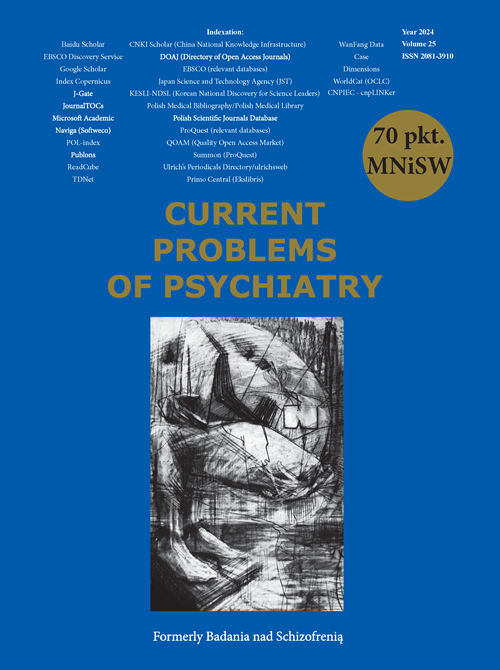The Significance of Natural Language Processing and Machine Learning in Schizophasia Description. Identification of Research Trends and Perspectives in Schizophrenia Language Studies
DOI:
https://doi.org/10.12923/2353-8627/2024-0013Keywords:
language, schizophasia, speech pathology, bibliomeric analysis, formal thought disorderAbstract
Introduction: Language and speech serve as significant biomarkers for psychiatric disorders, including schizophrenia. The linguistic features associated with schizophasia have been a focal point since the early descriptions of schizophrenia. Over the past twenty-five years, scientific reflection on language in mental illnesses has dynamically provided new data identifying the complex phenomenon of speech pathology in schizophrenia.
Material and methods: A bibliometric analysis was conducted using SCOPUS data, focusing on word co-occurrence patterns in schizophrenia research. VOSviewer was employed for visualization, and semantic relationships between words were explored.
Results: An analysis has revealed trends and gaps in research on schizophasia. Integrating temporal and spatial visualizations of metadata has allowed for the identification of currently employed measures of incoherence in schizophatic texts across various levels of linguistic organization. Keyword modeling has demonstrated a growing interest in utilizing artificial intelligence techniques to develop linguistic biomarkers for schizophrenia and other mental disorders.
Conclusions: The harmonization of computational methods for measuring narrative, dialogic, and prosodic coherence holds promise, particularly in cross-validation studies involving other neuroindicators of mental disorders. Developing linguistic biomarkers using broadly understood artificial intelligence requires multidisciplinary research teams integrating experts from psychiatry, neurolinguistics, neurologopedics, and AI engineering. Clear domain-specific regulations are essential to ensure accurate conclusions and ethical considerations. The study of schizophasia prospects is particularly evident at the lexical, semantic, and syntactic levels, along with affective and neurophysiological variables.
References
1. Czernikiewicz A. Przewodnik po zaburzeniach językowych w schizofrenii, Warszawa; Instytut Psychiatrii i Neurologii: 2004.
2. Grabias S. Teoria zaburzeń mowy. Perspektywy badań, typologie zaburzeń, procedury postępowania logopedycznego, W: Grabias S, Kurkowski M. (red.) Logopedia teoria zaburzeń mowy, Lublin; UMCS: 2012: 15–73.
3. Woźniak T. Zaburzenia mowy w schizofrenii, W: Grabias S, Kurkowski M. (red.) Logopedia teoria zaburzeń mowy, Lublin; UMCS: 2012: 645-678.
4. Van Eck NJ, Waltman L. Vosviewer: A computer program for bibliometric mapping. ERIM Report Series Reference No. ERS-2009-005-LIS. 2009.
5. Waltman L, van Eck NJ. Text mining and visualization using VOSviewer. ISSI Newsletter. 2011;7(3).
6. Waltman L, van Exk NJ, Noyons ECM. A unified approach to mapping and clustering of bibliometric networks. Journal of Informatrics. 2010;4(4).
7. Andreasen N, Grove W. Thought, language, and communication in schizophrenia: Diagnosis and prognosis. Schizophr. Bull. 1986;12:348–358.
8. de Boer J. Voices: a clinical computational psycholinguistic approach to language and hallucinations in schizophrenia spectrum disorders. [Thesis fully internal (DIV), University of Groningen]. University of Groningen. Groningen 2023. doi.org/10.33612/diss.668440255.
9. Czernikiewicz A, Woźniak T. Diagnoza psychologicznych zaburzeń mowy W: Milewski S, Czaplewska E. (red.), Diagnoza logopedyczna, Gdańsk 2012.
10. Bleuler E. Dementia praecox oder Gruppe der Schizophrenien. Leipzig: Deuticke; 1911.
11. Hernandez HC. Natural Language Processing Markers for Psychosis and Other Psychiatric Disorders: Emerging Themes and Research Agenda From a Cross-Linguistic Workshop. Schizophr. Bull. 2023;49(2):86-92.
12. Firth JR. Applications of general linguistics. Philological Society. 1957;56(1):1-14.
13. Cabuk T, et al. Natural Language Processing for defining linguistic features in schizophrenia: A sample from Turkish speakers. Schizophrenia Research. 2024;266:183-189.
14. Ehlen F, et al. Linguistic findngs in persons with schizophrenia – a review of the current literature. Frontiers in Psychology. Psychology of Language. 2023;14. doi.org/10.3389/fpsyg.2023.1287706.
15. Jeong L, et al. Exploring the Use of Natural Language Processing for Objective Assessment of Disorganized Speech in Schizophrenia. Psychiatric Research & Clinical Practice. 2023;5(3). doi.org/10.1176/appi.prcp.20230003.
16. Lin PY, et al. Deep Learning for schizophrenia classification based on natural language processing – A pilot study. Research Square, 2024 PREPRINT. doi.org/10.21203/rs.3.rs-3836497/v1.
17. Ryazanskaya G, Khudyakova M. Automated Analysis of Discourse Coherence in Schizophrenia: Approximation of Manual Measures. Language Resource and Evaluation Confernce 15-16.05.2020, Proceedings.
18. Just SA, et al. Validation of natural language processing methods capturing semantic incoherence in the speech of patients with non-affective psychosis, Sec. Schizophrenia, 2023;14. doi.org/10.3389/fpsyt.2023.1208856.
19. Corona-Hernandez H, et al. Assessing coherence throught linguistic connectivities: Analysis of speech in patients with schizophrenia-spectrum disorders Schizophrenia Research. 2023;259:48-58. doi.org/10.1016/j.schres.2022.06.013.
20. Corcoran CM, Carillo F, Fernandez-Slezak D, Bedi G, Klim C, Javitt DC, Bearden CF, Cecchi GA. Prediction of psychosis across protocols and risk cohorts using automated language analysis. World Psychiatry. 2018;17:67-75. doi: 10.1002/wps.20491.
21. Guillaume BF, et al. Poverty and inequality in real-world schizophrenia: a national study. Sec. Public Mental Health. 2023;11.
22. Rezaii N, Walker E, Wolff P. A machine learning approach to predicting psychosis using semantic density and latent content analysis. NPJ Schizophrenia. 2019;5(9). doi:10.7910/DVN/K9WKPV
23. Glaz LA, et al. Machine Learning and Natural Language Processing in Mental health: Systematic Review. Journal of Medical Internet Research. 2021;23(5). doi: 10.2196/15708
24. Gutierrez ED, Corlett PR, Corcoran CM, Cecchi GA. Using automated metaphor identification to aid in detection and prediction of first episode schizophrenia, in EMNLP 2017 – Conference on Empirical Method in Natural Language Processing, Proceedings, 2017.
25. Corcoran CM, Carillo F, Fernandez-Slezak D, Bedi G, Klim C, Javitt DC, Bearden CF, Cecchi GA. Prediction of psychosis across protocols and risk cohorts using automated language analysis. World Psychiatry. 2018;17:67-75.
26. Bedi G, Carrillo F, Cecchi GA, Fernandez-Slezak D, Sigman M, Mota NB, Riberto S, Javitt DS, Copelli M, Corcoran CM. Automated analysis of free speech predicts psychosis onset in high-risk youths. NPJ Schizophrenia. 2015:1.
27. Gupta T, Hespos SJ, Horton WS, Mittal VA. Automated analysis of written narratives receals abnormalities in referential cohesion in youth at ultra high risk for psychosis. Schizophrenia Research. 2018;192:82-88.
28. Huang KU, Wu CH, Su MH, Kuo YT. Detecting unipolar and bipolar depressive disorers from elicited speech responses using latent affective structure model. IEE Trans Affect Comput. 2020;11(3):393-404.
29. Lipski W. Zaburzenia konotacji w schizofrenii. Lublin; UMCS: 2018.
Downloads
Published
Issue
Section
License
Copyright (c) 2024 Authors

This work is licensed under a Creative Commons Attribution 4.0 International License.


